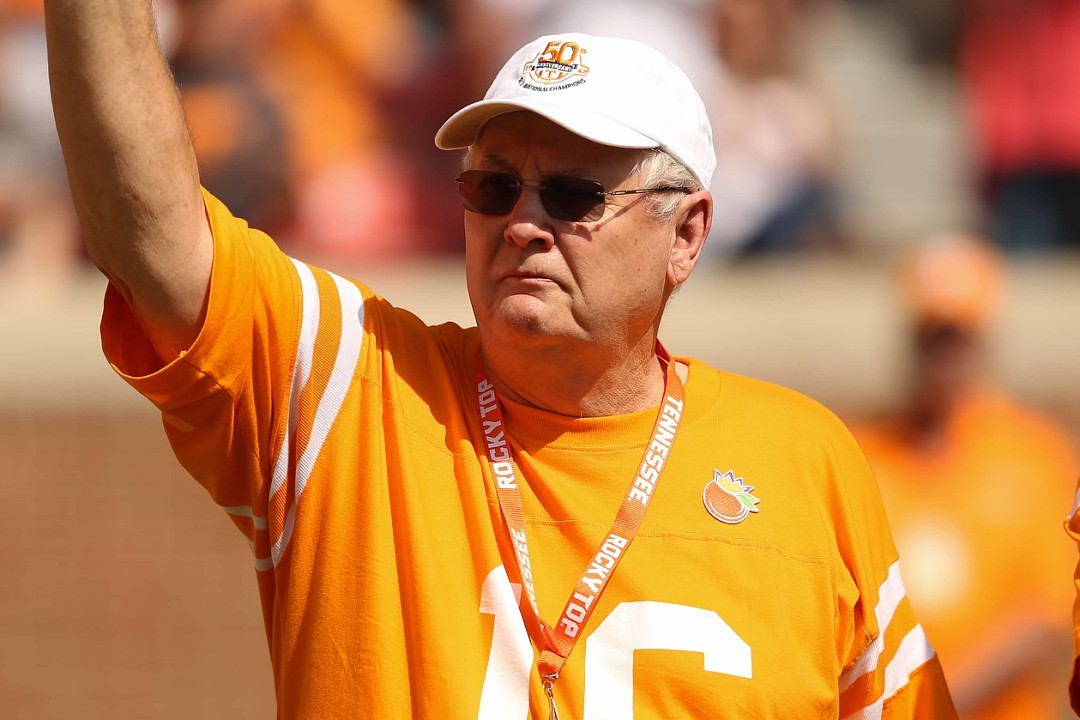There is a giant gap in time and distance between Dewey Warren and Brigham Young University.
Dewey, former Tennessee quarterback, the proverbial Swamp Rat, was in Provo, Utah, for just a little while but he made an enormous difference. He created and installed the passing game that helped make coach LaVell Edwards and a dozen quarterbacks famous.
Somebody remembered. A BYU television crew came to Knoxville this summer to gather Dewey recollections for a one-hour preview of Saturday’s game.
LaVell Edwards, a defensive specialist, became head coach in 1972. He knew he lacked the talented athletes necessary to win consistently with a conventional running attack. He went looking for an offensive mind with expertise in the passing game.
Edwards knew Lon Herzbrun, former Volunteer, former Fulton High coach, former Tennessee assistant. Herzbrun recommended Dewey.
The Swamp Rat was already a legend. It says so in my second book, “Legends of the Tennessee Vols,” page 109, big picture on 110.
What a story …
It was an upset when a University of Tennessee scholarship was bestowed upon Dewey Warren, then of the marshland along the Vernon River outside Savannah, Ga. He beat long odds, rose above the scout squad, did what many thought was impossible and emerged, in a moment of need, as a truly magnetic personality, a Pied Piper who led the Volunteers far above expectations.
Dewey had a feel for the game. He had enough arm. He had the heart of a lion. Teammates sang songs about him and smiled at some of his antics but recognized him as a winner.
He was best remembered for the longest, slowest one-yard run ever, the one that beat UCLA in the “Rosebonnet” Bowl. Ray Trail, former line coach at Tennessee, never believed his eyes.
“Dewey couldn’t run. He wasn’t tall enough to see over the line. But he was tough. And he could throw the football. That’s about all he could do.
“No, that’s not right. He was a fearless competitor, a good leader and the subject of many a tall tale.”
The story gets better. Warren was drafted by the Cincinnati Bengals. He learned some more about the passing game. After the NFL, after a fling with the Las Vegas Cowboys of the Continental League, he became low man on the UT coaching staff. After that, he went to BYU.
I must say this delicately. The Swamp Rat was not a perfect fit for the Mormon school. He had to trim his sideburns and learn at least a little something about church discipline.
Dewey had scalped a few tickets in his time and had fleeced the farmers of Tellico Plains who bet on the quarter horse to outrun Richmond Flowers in the featured race at a rodeo.
Warren, bright guy, beat the boss to work on his first day in Provo. Coach Edwards came in and caught the smell of fresh-brewed coffee.
“You want some?” asked Dewey.
“Coffee is not permitted on the BYU campus,” said Edwards in a gentle, but firm coaching tip.
Dewey poured out some really good coffee.
Dewey poured in a terrific passing plan. He turned every running play into a possible pass. He overwhelmed defenses with five receivers.
Norm Chow, another offensive genius, said a basic reason for the success of the Warren vision was simplicity. There weren’t a lot of basic plays but they could be run from a variety of formations. Some were created for extra versatility.
Players knew the offense by the second day of practice.
A junior college quarterback, Gary Sheide, was imported to implement the plan. Sheide looked like Joe Namath throwing a football. He had great success. Opposing defensive coordinators overreacted. BYU running back Pete Van Valkenburg won the NCAA rushing title.
Edwards gave Warren full credit for what he did in the early 1970s. What he did is now regarded as a precursor of the West Coast offense made famous by coach Bill Walsh and the San Francisco 49ers.
Walsh and Warren knew each other. Walsh was a Paul Brown assistant with the Bengals when Warren was quarterback.
Dewey remembers the week Walsh came to Provo to see what the Swamp Rat was doing – keys, routes, reads, the idea of short passes that opened up lanes for bigger gains. The offense was designed to stretch the field vertically and horizontally. It involved clear-out routes to create seams for the tight end and flare vacancies for running backs.
Nobody ever said the Swamp Rat was dumb.
Dewey has fond memories of his two seasons at BYU. LaVell Edwards let Dewey do his thing.
“The head coach called one play in two years,” said Warren. “It lost 15 yards. LaVell said if he ever tried to butt in again, to just tell him no.”
Instead of building on success, Dewey made the miserable mistake of moving to Kansas State because another former UT assistant, Vince Gibson, needed him. Together, they got fired.
Faced with harsh unemployment, Dewey retreated to Copper Basin High School. There were 23 players and the field didn’t have enough grass to mow. And, there wasn’t enough lime for Dewey to complete all the lines.
After that, he helped the University of the South. After that, he was OK in sales and good on sports talk radio. He was as good or better on golf courses.
The Swamp Rat will be very interested in Saturday. BYU is suddenly a crucial game for the Volunteers.
Marvin West welcomes reader remarks or questions. His address is marvinwest75@gmail.com

